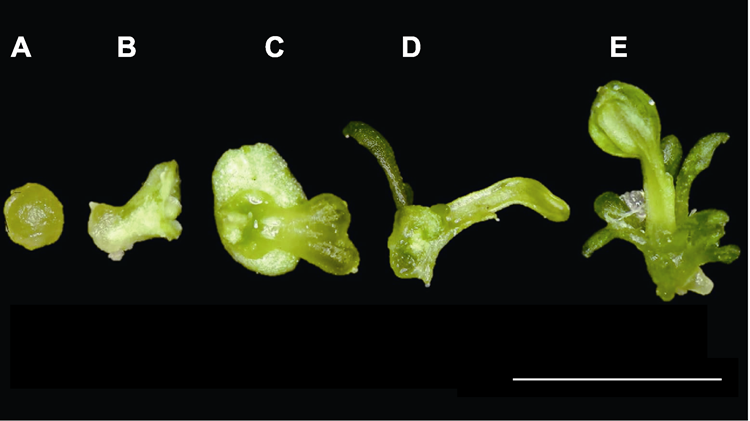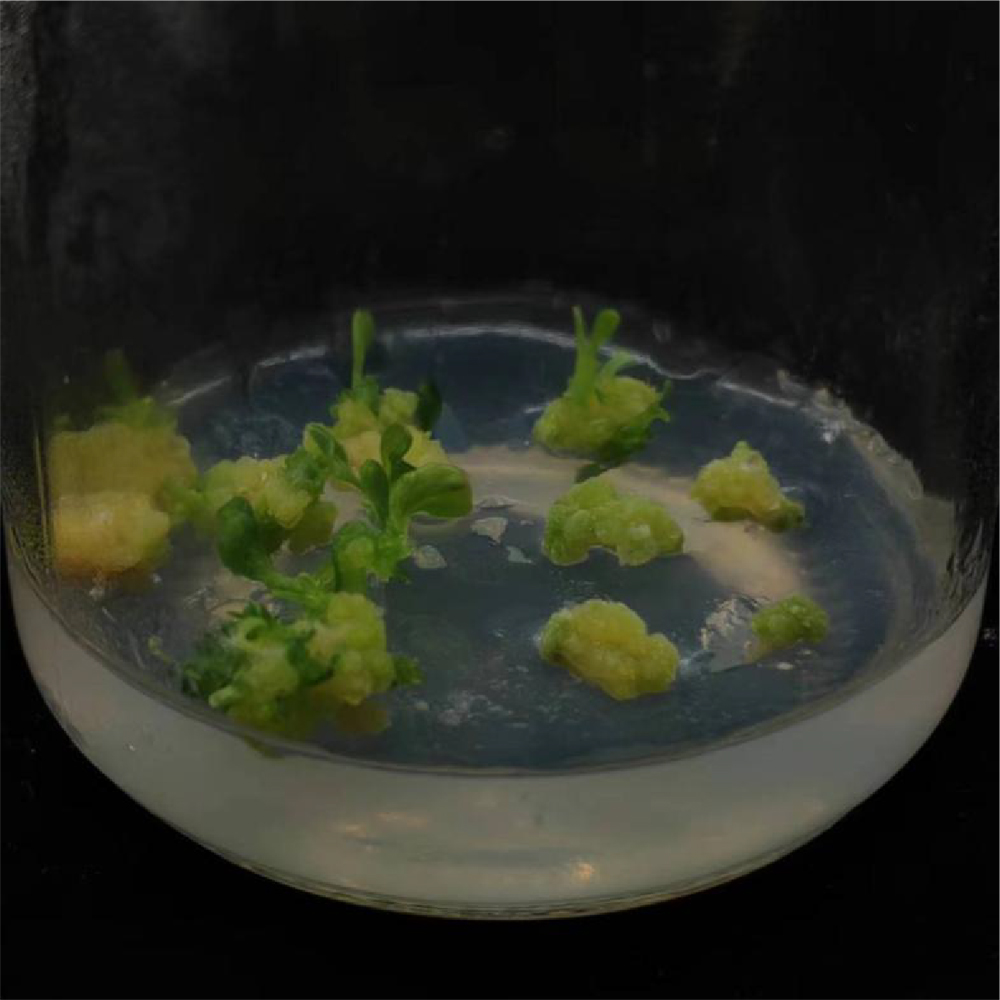

Establishment of a Regeneration System for Viola × wittrockiana
Received date: 2024-10-28
Accepted date: 2025-02-22
Online published: 2025-02-26
INTRODUCTION: Viola × wittrockiana, a member of the Violaceae family, is recognized as a commercially valuable ornamental species due to its diverse flower colors and potential medicinal applications. However, its vegetative propagation via tissue culture has been limited by challenges such as low regeneration efficiency, procedural complexity in existing protocols, and genotype-dependent regeneration capacity. Previous attempts to establish regeneration systems for this species have been reported, but issues including inconsistent callus differentiation, low adventitious bud formation rates, and high dependency on explant quality remain unresolved. Consequently, the development of a stable and efficient regeneration system is considered critical for enabling biotechnological advancements, including genetic transformation and large-scale propagation of elite cultivars. A systematic approach focusing on genotype screening, explant selection, and optimization of plant growth regulator combinations is required to address these limitations and facilitate the species’ genetic improvement.
RATIONALE: Regeneration capacity in plants is highly influenced by genotype. This study aimed to optimize the regeneration system for V. × wittrockiana by screening eight cultivars and selecting petioles as superior explants due to their higher callus differentiation potential. Key factors, including plant growth regulators (2,4-D, KT, 6-BA) and carbohydrate sources (sucrose, maltose, trehalose), were systematically evaluated. Repeated induction cycles were employed to enrich high-regeneration genotypes, enhancing overall efficiency and reproducibility.
RESULTS: Petioles were identified as superior explants, exhibiting a significantly higher callus induction rate (91.90%) compared to leaves (49.65%) across eight V. × wittrockiana cultivars, with the highest differentiation efficiency (15.83%) observed in the PXP cultivar. The optimal callus induction medium was determined to be 1/2MS (sugar-free) supplemented with 30 g∙L-1 sucrose, 1.5 mg∙L-1 2,4-D, and 1.5 mg∙L-1 KT, achieving a differentiation rate of 18.52%. For adventitious bud induction, the highest regeneration efficiency (67.33±3.06)% was obtained through repeated induction cycles using 1/2MS (sugar-free) containing 30 g∙L-1 trehalose, 0.05 mg∙L-1 2,4-D, and 3 mg∙L-1 6-BA. Proliferation of adventitious buds was maximized on MS (sugar-free) medium with 30 g∙L-1 trehalose, 0.5 mg∙L-1 2,4-D, and 1 mg∙L-1 6-BA, yielding a proliferation coefficient of 3.29±0.22. Rooting of regenerated shoots was successfully achieved (84.44±6.93)% on 1/2MS medium containing 0.1 mg∙L-1 NAA, followed by acclimatization with a survival rate exceeding 85%, validating the efficacy of the established regeneration protocol.
CONCLUSION: This study established a petiole-based high-efficiency regeneration system for V. × wittrockiana through genotype screening, media optimization, and repeated induction of high-regeneration genotypes. The protocol significantly improved adventitious bud differentiation rates (67.33%), addressing long-standing challenges in regeneration of this species. The system provides a robust technical foundation for genetic transformation, gene function studies, and large-scale propagation, thereby facilitating the commercial development and biotechnological advancement of this economically valuable species.

Observation of somatic embryo developmental stages during pansy regeneration. (A) Spherical embryo; (B) Heart-shaped embryo; (C) Torpedo-shaped embryo; (D) Cotyledon embryo; (E) Mature adventitious bud. Bar=1 cm

Ruxin Zhang , Chenrong Li , Tongxin Wang , Jie Li , Tingge Li , Huixian Xu , Meier Li , Ying Zhao , Ting Peng , Jian Wang . Establishment of a Regeneration System for Viola × wittrockiana[J]. Chinese Bulletin of Botany, 2025 , 60(6) : 968 -977 . DOI: 10.11983/CBB24164
| [1] | Ameri A, Davarynejad GH, Moshtaghi N, Tehranifar A (2020). The role of carbohydrates on the induction of somatic embryogenesis and the biochemical state of the embryogenic callus in Pyrus communis L. cv. ‘Dar Gazi’. Erwerbs-Obstbau 62, 411-419. |
| [2] | Babber S, Kulbhushan S (1991). Study of anatomy of vitrified structure in Viola tricolour L. Ann Biol 7, 93-95. |
| [3] | Bhardwaj R, Kumar M, Kaushal N, Kamboj AD, Krishnamoorthi A, Singh A, Motla R, Anushi (2024). From lab to bouquet: the biotechnological frontier in modern floriculture for sustainable and resilient flower farming. J Adv Biol Biotechnol 27, 119-137. |
| [4] | Chen YR (2013). The Transformation of Cold Response Gene CBF1 Into Petunia (Petunia hybrida Vilm.) and Pansy (Viola tricolor L.). Master’s thesis. Lanzhou: Lanzhou University. pp. 1-37. (in Chinese) |
| 陈玥如 (2013). 冷响应基因CBF1对矮牵牛和三色堇的遗传转化研究. 硕士论文. 兰州: 兰州大学. pp. 1-37. | |
| [5] | Ding SP, Yan JQ, Ji DF (1998). Effect of sugar sources on plant tissue culture. Chin Bull Bot 15, 42-46. (in Chinese) |
| 丁世萍, 严菊强, 季道藩 (1998). 糖类在植物组织培养中的效应. 植物学通报 15, 42-46. | |
| [6] | Encina CL, Parisi A, O’Brien C, Mitter N (2014). Enhan-cing somatic embryogenesis in avocado (Persea americana Mill.) using a two-step culture system and including glutamine in the culture medium. Sci Hortic 165, 44-50. |
| [7] | Fernandes L, Ramalhosa E, Baptista P, Pereira JA, Saraiva JA, Casal SIP (2019). Nutritional and nutraceutical composition of pansies (Viola × wittrockiana) during flowering. J Food Sci 84, 490-498. |
| [8] | Fu JM, Guo HJ, Lou YH (2014). Method for improving pe-rennial ryegrass callus regeneration rate. Chinese Patent, CN103314860B. 2014-08-13. (in Chinese) |
| 傅金民, 郭慧娟, 娄燕宏 (2014). 一种提高多年生黑麦草愈伤组织再生率的方法. 中国专利, CN103314860B. 2014-08-13. | |
| [9] | Gandolfo E, Hakim G, Geraci J, Feuring V, Giardina E, Di Benedetto A (2016). Responses of pansy (Viola wittrockiana Gams.) to the quality of the growing media. J Exp Agric Int 12, 1-10. |
| [10] | Gon?alves J, Borges JCF, Carlos LDA, Silva APCM, Souza FAD (2019). Bioactive compounds in edible flowers of garden pansy in response to irrigation and mycorrhizal inoculation. Rev Ceres 66, 407-415. |
| [11] | González-Barrio R, Periago MJ, Luna-Recio C, Garcia- Alonso FJ, Navarro-González I (2018). Chemical composition of the edible flowers, pansy (Viola wittrockiana) and snapdragon (Antirrhinum majus) as new sources of bioactive compounds. Food Chem 252, 373-380. |
| [12] | Jha SR, Naz R, Asif A, Okla MK, Soufan W, Al-Ghamdi AA, Ahmad A (2020). Development of an in vitro propagation protocol and a sequence characterized amplified region (SCAR) marker of Viola serpens Wall. ex Ging. Plants 9, 246. |
| [13] | Jheng FY, Do YY, Liauh YW, Chung JP, Huang PL (2006). Enhancement of growth and regeneration efficiency from embryogenic callus cultures of Oncidium ‘Gower Ramsey’ by adjusting carbohydrate sources. Plant Sci 170, 1133-1140. |
| [14] | Khajuria AK, Hano C, Bisht NS (2021). Somatic embryogenesis and plant regeneration in Viola canescens Wall. ex. Roxb.: an endangered himalayan herb. Plants 10, 761. |
| [15] | Li XQ, Sheng YH, Fu YG, Zhou Y, Zhao Y, Ling P, Song XQ, Wang J (2020). Establishment of efficient regeneration system of Oncidium. J South Agric 51, 1169-1175. (in Chinese) |
| 李雪青, 盛玉辉, 付瑛格, 周扬, 赵莹, 凌鹏, 宋希强, 王健 (2020). 文心兰高效再生体系的建立. 南方农业学报 51, 1169-1175. | |
| [16] | Long Y, Yang Y, Pan GT, Shen YO (2022). New insights into tissue culture plant-regeneration mechanisms. Front Plant Sci 13, 9267s52. |
| [17] | Ma J, Li Q, Zhang L, Cai S, Liu YY, Lin JC, Huang RF, Yu YQ, Wen MZ, Xu TD (2022). High auxin stimulates callus through SDG8-mediated histone H3K36 methylation in Arabidopsis. J Integr Plant Biol 64, 2425-2437. |
| [18] | Mercuri A, Sacchetti A, De Benedetti L, Schiva T, Alberti S (2002). Green fluorescent flowers. Plant Sci 162, 647-654. |
| [19] | Nanjaraj Urs AN, Hu YL, Li PW, Yuchi Z, Chen YH, Zhang Y (2019). Cloning and expression of a nonribosomal peptide synthetase to generate blue rose. ACS Synth Biol 8, 1698-1704. |
| [20] | Nauenburg JD, Buttler KP (2007). Validierung des namens Viola wittrockiana. Kochia 2, 37-41. |
| [21] | Niu YY, Wang M, Li WJ, Li B, Fan MJ, Cheng YH, Wang CF (2023). Cultivation technical regulations of Viola tricolor. Hortic Seed 43(7), 45-46. (in Chinese) |
| 牛燕燕, 王梅, 李文静, 李冰, 范明杰, 成永慧, 王超凡 (2023). 三色堇栽培技术规程. 园艺与种苗 43(7), 45-46. | |
| [22] | Nú?ez S, López V, Moliner C, Valero MS, Gómez-Rincón C (2023). Lipid lowering and anti-ageing effects of edible flowers of Viola × wittrockiana Gams in a Caenorhabditis elegans obese model. Food Funct 14, 8854-8864. |
| [23] | Satyavathi VV, Jauhar PP, Elias EM, Rao MB (2004). Effects of growth regulators on in vitro plant regeneration in durum wheat. Crop Sci 44, 1839-1846. |
| [24] | Tang J, Wang CK, Pan XL, Yan H, Zeng GZ, Xu WY, He WJ, Daly NL, Craik DJ, Tan NH (2010). Isolation and characterization of cytotoxic cyclotides from Viola tricolor. Peptides 31, 1434-1440. |
| [25] | Vukics V, Kery A, Guttman A (2008). Analysis of polar antioxidants in heartsease (Viola tricolor L.) and garden pansy (Viola × wittrockiana Gams.). J Chromatogr Sci 46, 823-827. |
| [26] | Wang J, Bao MZ (2007). Plant regeneration of pansy (Viola wittrockiana) ‘Caidie’ via petiole-derived callus. Sci Hortic 111, 266-270. |
| [27] | Wijowska M, Kuta E, Przywara L (1999). In vitro culture of unfertilized ovules of Viola odorata L. Acta Biol Cracov Ser Bot 41, 95-101. |
| [28] | Wu Q, Qin JJ, Chen W, Su X (2016). Research on the tissue culture and rapid propagation of medicinal plant Viola philippica. J Tradit Chin Vet Med 35(3), 5-8. (in Chinese) |
| 吴琼, 秦晶晶, 陈纹, 苏雪 (2016). 药用植物紫花地丁组织培养与快速繁殖技术研究. 中兽医医药杂志 35(3), 5-8. | |
| [29] | Xu JP, Naing AH, Bunch H, Jeong J, Kim H, Kim CK (2021). Enhancement of the flower longevity of petunia by CRISPR/Cas9-mediated targeted editing of ethylene biosynthesis genes. Postharvest Biol Technol 174, 111460. |
| [30] | Yang JL, Rao YF, Zhang RH, Zhou GL, Lin CF, He YH, Ning GG (2024). Establishment of an efficient leaf regeneration system for Pinguicula. Chin Bull Bot 59, 626-634. (in Chinese) |
| 杨佳丽, 饶羽菲, 张润花, 周国林, 林处发, 何燕红, 宁国贵 (2024). 捕虫堇叶片高效再生体系建立. 植物学报 59, 626-634. | |
| [31] | Zhang ML (2021). Establishment of Suspension Cells in Chinese Jujube (Ziziphus jujuba Mill.) and Its Application in cAMP Synthesis and Regulation. Master’s thesis. Baoding: Hebei Agricultural University. pp. 1-35. (in Chinese) |
| 张梦玲 (2021). 枣悬浮细胞系的建立及其在cAMP合成调控中的应用. 硕士论文. 保定: 河北农业大学. pp. 1-35. | |
| [32] | Zhang QS (2009). Studies on Inheritance of Flower Color and Flower Color Patter and Tissue Culture of Pansy (Viola × wittrockiana) and Viola (V. cornuta). Master’s thesis. Wuhan: Huazhong Agricultural University. pp. 1-63. (in Chinese) |
| 张其生 (2009). 三色堇与角堇花色、花斑遗传规律及组织培养的研究. 硕士论文. 武汉: 华中农业大学. pp. 1-63. |
/
| 〈 |
|
〉 |